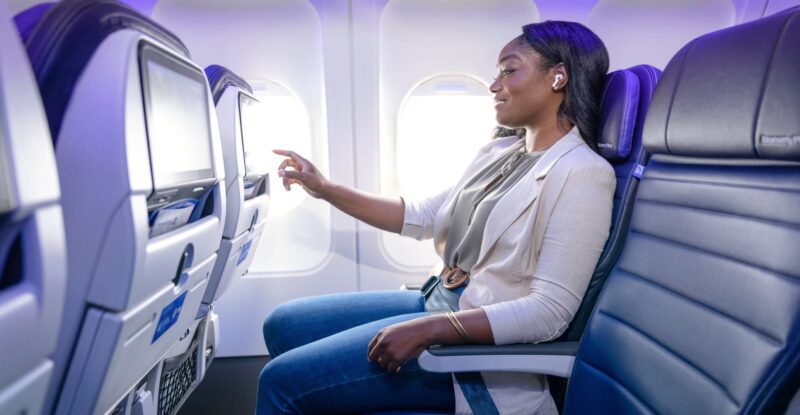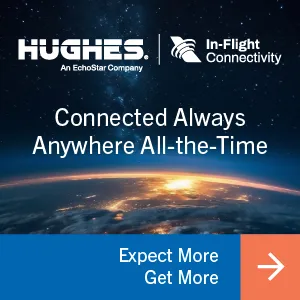Will high-speed inflight connectivity disrupt the embedded inflight entertainment world, and ultimately sound the death knell for seatback IFE on board aircraft? This hoary chestnut of a question has been asked since broadband IFC first debuted in commercial aviation with Lufthansa’s 2004 introduction of the Connexion by Boeing Ku-band geostationary satcom service.
Over two decades later, the same question is still being asked in some circles but now it carries a bit more weight as Low Earth Orbit (LEO) and multi-orbit inflight connectivity systems demonstrate the art of the possible: passengers flying on equipped aircraft can consistently avail of an at-home Internet experience in the sky.
Among the carriers at the forefront of adopting LEO-based IFC, United Airlines is presently in the process of fitting its entire fleet with SpaceX’s Starlink service in a bid to power free Wi-Fi for members of its MileagePlus loyalty program.
But even as United moves with speed to bring Starlink to its fleet — it has equipped more than half of its regional jets and recently installed the system on its first Boeing 737-800 — the US major is also adding Panasonic Avionics seatback IFE systems to its narrowbodies and bringing larger screens to its new widebodies. Roughly 1,000 aircraft in United’s fleet are expected to carry seatback screens by the end of 2026 or early 2027.
NPS score boost
In a world where most people have smartphones and tablets, why would United bother to install Bluetooth-enabled seatback screens across its mainline fleet?
For the answer we turn to United Airlines EVP and CFO Mike Leskinen, who studies United’s business from a numbers’ perspective, and is fully aware that embedded IFE represents a significant upfront investment in the hardware, the installation, the testing and the certification, not to mention the weight it adds to planes which in turn increases fuel burn.
“[T]hose screens, along with the high bandwidth Wi-Fi, make our customer’s journey infinitely better,” Leskinen said on 3 September in a highly revelatory post on LinkedIn.
He explained:
We offer a differentiated product in what has historically been a commoditized business, and that is driving brand loyal customers to choose United every time they fly. And that’s worth every penny.
Leisure customers are rating their travel experience more highly and business travelers are more productive, proving the right investments in high-quality IFE drive stronger Net Promoter Scores, increased brand loyalty, and positive differentiation from competitors, which all translate into revenue growth and higher more sustainable profits.
Seatback IFE, meanwhile, has long been a core feature of the passenger experience on Delta Air Lines’ mainline fleet, and the US major is now flying 165,000 seatback screens across over 930 aircraft — more than any other US-based airline.
Seemingly small tweak, big wellness impact
After sitting down with Delta’s general manager of customer research and advisor, Lizzy Martinez this spring, New York Times best-selling author and loyalty expert Fred Reichheld revealed what he learned in a LinkedIn post titled ‘Delta’s Ascent: How a Legacy Airline Earned a Leader’s Spot in Loyalty.’
He said:
Delta’s service philosophy is grounded in three brand beliefs: Make customers feel welcomed, elevated, and cared for. These aren’t just words — they’re operationalized through training and frontline behaviors.
Using biometric data and customer sentiment analysis from volunteers, Delta mapped the emotional peaks and valleys across the travel journey. One surprising insight? Stress levels drop the moment customers sit down. To make that moment even sweeter, Delta turned on seatback entertainment as soon as passengers board — no need to wait to reach 30,000 feet. A small tweak, a big impact.
Of note: both United and Delta have bolstered their IFE content partnerships in recent months. The former is adding Spotify audiobooks and podcasts as well as select Apple TV+ hits to seatback screens and personal devices, and the latter is providing ad-free access to a selection of YouTube videos, podcasts and music playlists.
These types of collaborations are smart for several reasons: they deliver content created for the direct-to-consumer (D2C) market but not explicitly over a live inflight connectivity pipe which preserves costly bandwidth.
They also expose the brand and the D2C exclusive content to passengers, which can generate subscriptions. To wit, Delta says SkyMiles Members logged into Delta Sync Wi-Fi can unlock “a 14-day free preview of YouTube Premium on Delta Wi-Fi-enabled flights within the U.S”. No form of payment is required, though a Google account is needed (and set-up can be facilitated by the free Wi-Fi).
Additionally, such arrangements ensure that airlines are not falling afoul of content creators’ licensing rights, as there is some legal uncertainty right now around whether airlines should advertise streaming OTT to passengers.
“No major streaming service explicitly permits inflight access under standard terms and conditions. Inflight licensing is handled separately, via airline and content owner agreements, not through general streaming terms,” Airline Passenger Experience Association (APEX) CEO Dr. Joe Leader warned during the APEX Global EXPO in Long Beach. APEX and major studios will update industry on the state of play at the APEX TECH conference in Los Angeles in January.
Keeping pace with rapid change
The endurance of seatback IFE and its positive impact on both NPS scores and passenger wellbeing is no surprise to Panasonic Avionics, which is a key partner to both United and Delta, and counts United as a launch customer for its modular nextgen Astrova system.
“I’ve been in this industry since 1991 and my personal belief — and I’ve seen so many predictions of the death of IFE, you know, over and over again — is I don’t think this is the death of IFE because the business just keeps getting bigger,” Panasonic Avionics vice president of digital solutions Andrew Mohr said of the impact on embedded IFE of low-latency LEO connectivity.
During a sit-down interview at the offices of Malmö, Sweden-based Tactel, the digital interaction agency that Panasonic acquired in 2015, Mohr told Runway Girl Network: “You know, the iPad was supposed to kill it. Little personal video players were supposed to kill it.”
At the same time, Panasonic is fully aware it cannot rest on its laurels. LEO and multi-orbit IFC, for which Panasonic also supports with its own solutions, are “probably the most disruptive thing that’s going to happen” since overhead IFE displays transitioned to individual AVOD screens in the seat, Mohr said.
That’s why Panasonic is moving with the times, becoming more agile, offering new software suites — including tools that enable airlines to take full control of their digital experience — and supporting industry’s transition to a ‘connected seatback’ where personalization takes center stage.
“The potential for actually this being integrated and being very transformative is huge,” Mohr said.
A renewed focus on inflight wellness is also in the cards. “It’s a big untapped category actually for an IFE supplier because it’s the number one concern,” the Panasonic executive noted.
Related Articles:
- Studios warn airlines: don’t bypass content rights in flight
- Why seatback IFE is core to United Airlines’ premium push
- Largely positive Delta 767 flight reveals PaxEx vulnerabilities
- United looks to set long-haul premium standard with Elevated 787-9
- How Delta Sync seatback demonstrably improves PaxEx
- Delta seeks to gain edge with Thales FlytEDGE, eyes multi-network IFC
- VIDEO: Delta innovates with Hughes partnership, IFEC integration
- #PaxEx Podcast: Panasonic’s Masson on disruptors shaping IFE
Featured image credited to United Airlines












